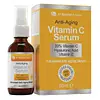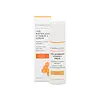What's inside
What's inside
 Key Ingredients
Key Ingredients

 Benefits
Benefits

 Concerns
Concerns

No concerns
 Ingredients Side-by-side
Ingredients Side-by-side

Water
Skin ConditioningSodium Ascorbyl Phosphate
AntioxidantHamamelis Virginiana Water
AstringentCassia Angustifolia Seed Polysaccharide
Skin ConditioningDimethyl Sulfone
SolventTocopheryl Acetate
AntioxidantAloe Barbadensis Leaf Extract
EmollientFerulic Acid
AntimicrobialGlycerin
HumectantSynthetic Jojoba Oil
EmollientCentella Asiatica Extract
CleansingEquisetum Arvense Extract
AstringentGeranium Maculatum Extract
TonicArginine
MaskingC10-30 Alkyl Acrylate
Ethylhexylglycerin
Skin ConditioningCitrus Aurantium Dulcis Peel Oil
MaskingWater, Sodium Ascorbyl Phosphate, Hamamelis Virginiana Water, Cassia Angustifolia Seed Polysaccharide, Dimethyl Sulfone, Tocopheryl Acetate, Aloe Barbadensis Leaf Extract, Ferulic Acid, Glycerin, Synthetic Jojoba Oil, Centella Asiatica Extract, Equisetum Arvense Extract, Geranium Maculatum Extract, Arginine, C10-30 Alkyl Acrylate, Ethylhexylglycerin, Citrus Aurantium Dulcis Peel Oil
 Reviews
Reviews

Ingredients Explained
These ingredients are found in both products.
Ingredients higher up in an ingredient list are typically present in a larger amount.
Ferulic Acid is a plant based antioxidant. By fighting free-radicals, ferulic acid can help reduce the formation of fine lines and hyperpigmentation.
When used with Vitamin C, Ferulic Acid has shown to prevent Vitamin C from breaking down. In other words, it acts as a stabilizer.
Ferulic Acid is sometimes used to preserve food. Foods containing Ferulic Acid include: oats, rice, eggplant, citrus.
In medicine, Ferulic Acid is being studied for helping with diabetes, Alzheimer's, and cardiovascular diseases.
Learn more about Ferulic AcidGlycerin is already naturally found in your skin. It helps moisturize and protect your skin.
A study from 2016 found glycerin to be more effective as a humectant than AHAs and hyaluronic acid.
As a humectant, it helps the skin stay hydrated by pulling moisture to your skin. The low molecular weight of glycerin allows it to pull moisture into the deeper layers of your skin.
Hydrated skin improves your skin barrier; Your skin barrier helps protect against irritants and bacteria.
Glycerin has also been found to have antimicrobial and antiviral properties. Due to these properties, glycerin is often used in wound and burn treatments.
In cosmetics, glycerin is usually derived from plants such as soybean or palm. However, it can also be sourced from animals, such as tallow or animal fat.
This ingredient is organic, colorless, odorless, and non-toxic.
Glycerin is the name for this ingredient in American English. British English uses Glycerol/Glycerine.
Learn more about Glycerin